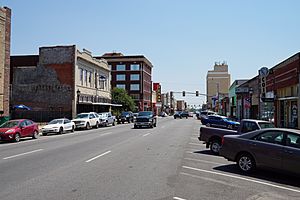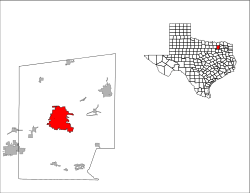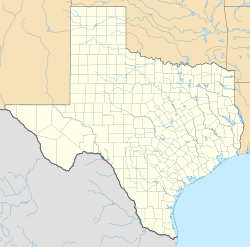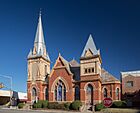Greenville, Texas facts for kids
Quick facts for kids
Greenville, Texas
|
||
|---|---|---|

Lee Street in downtown Greenville
|
||
|
||
| Motto(s):
"Rich Heritage, Vibrant Future"
|
||

Location of Greenville in Hunt County, Texas
|
||
| Country | ||
| State | ||
| County | Hunt | |
| Incorporated | April 13, 1852 | |
| Named for | Thomas J. Green | |
| Government | ||
| • Type | Council-Manager | |
| Area | ||
| • Total | 33.11 sq mi (85.75 km2) | |
| • Land | 32.29 sq mi (83.62 km2) | |
| • Water | 0.82 sq mi (2.12 km2) | |
| Elevation | 564 ft (172 m) | |
| Population
(2020)
|
||
| • Total | 28,164 | |
| • Density | 850.62/sq mi (328.443/km2) | |
| Time zone | UTC-6 (Central (CST)) | |
| • Summer (DST) | UTC-5 (CDT) | |
| ZIP codes |
75401–75404
|
|
| Area code(s) | 903, 430 | |
| FIPS code | 48-30920 | |
| GNIS feature ID | 2410660 | |
Greenville is a city in Hunt County, Texas, United States. It's located in Northeast Texas, about 50 miles (80 km) northeast of Dallas, Texas. Greenville is the main city and county seat of Hunt County. In 2020, about 28,164 people lived there.
The city was named after Thomas J. Green, who helped create the Texas Republic.
Contents
History of Greenville
Greenville was founded in 1846. It was named after Thomas J. Green, who was important in forming the Texas Republic. He later became a member of the Texas Republic's Congress.
Civil War and Cotton Era
Before the American Civil War, people in Greenville were divided about whether to leave the United States. Some residents fought for the Union, while others fought for the Confederacy. A historical marker in "The SPOT" Park in downtown Greenville remembers this division. After the war, Greenville's economy relied a lot on cotton.
By 1920, Greenville had a population of 12,384, making it the 20th largest city in Texas.
World War II and the "Welcome" Sign
During World War II, the Mexican Escuadrón 201 (a fighter squadron) was stationed in Greenville. They trained at Majors Field nearby.
Greenville was once known for a large sign over Lee Street. It was put up in 1921 and said: "Welcome to Greenville, The Blackest Land, The Whitest People." This sign had a meaning that was not fair to Black people. Because of this, the original sign was taken down in 1965. In 1968, a new sign was put up that said "The Greatest People." The original sign is now at the Audie Murphy American Cotton Museum.
In 1957, Greenville added the small town of Peniel. Peniel was founded in 1899 as a religious community.
Lightning Medicine Cloud
On May 12, 2011, a rare white buffalo calf was born near Greenville. It was named "Lightning Medicine Cloud." Sadly, it died in August 2012.
Geography and Climate
Greenville is located in Northeast Texas, in the middle of Hunt County. It's in an area known for its rich, dark soil called the Texas blackland prairies. The city is about 50 miles (80 km) northeast of Dallas.
The city covers about 33.11 square miles (85.75 km²). Most of this is land, with a small part being water. The Cowleech Fork of the Sabine River flows through the northeastern part of the city.
Greenville's Weather
Greenville has a humid subtropical climate. This means it usually has humid weather with a moderate amount of rain.
| Climate data for Greenville, Texas (1991–2020 normals, extremes 1900–present) | |||||||||||||
|---|---|---|---|---|---|---|---|---|---|---|---|---|---|
| Month | Jan | Feb | Mar | Apr | May | Jun | Jul | Aug | Sep | Oct | Nov | Dec | Year |
| Record high °F (°C) | 90 (32) |
95 (35) |
95 (35) |
101 (38) |
104 (40) |
109 (43) |
113 (45) |
116 (47) |
109 (43) |
103 (39) |
91 (33) |
87 (31) |
116 (47) |
| Mean daily maximum °F (°C) | 57.8 (14.3) |
61.7 (16.5) |
69.3 (20.7) |
77.4 (25.2) |
84.6 (29.2) |
92.6 (33.7) |
97.1 (36.2) |
98.3 (36.8) |
91.3 (32.9) |
80.7 (27.1) |
68.3 (20.2) |
59.5 (15.3) |
78.2 (25.7) |
| Daily mean °F (°C) | 45.5 (7.5) |
49.4 (9.7) |
56.7 (13.7) |
64.8 (18.2) |
73.2 (22.9) |
81.4 (27.4) |
85.6 (29.8) |
85.8 (29.9) |
78.4 (25.8) |
67.3 (19.6) |
55.9 (13.3) |
47.5 (8.6) |
66.0 (18.9) |
| Mean daily minimum °F (°C) | 33.3 (0.7) |
37.2 (2.9) |
44.2 (6.8) |
52.2 (11.2) |
61.9 (16.6) |
70.2 (21.2) |
74.1 (23.4) |
73.3 (22.9) |
65.6 (18.7) |
54.0 (12.2) |
43.4 (6.3) |
35.5 (1.9) |
53.7 (12.1) |
| Record low °F (°C) | −4 (−20) |
0 (−18) |
8 (−13) |
26 (−3) |
31 (−1) |
48 (9) |
55 (13) |
49 (9) |
36 (2) |
21 (−6) |
13 (−11) |
−3 (−19) |
−4 (−20) |
| Average precipitation inches (mm) | 3.16 (80) |
3.46 (88) |
4.42 (112) |
4.12 (105) |
5.79 (147) |
4.16 (106) |
3.15 (80) |
2.39 (61) |
3.84 (98) |
4.96 (126) |
3.58 (91) |
3.98 (101) |
47.01 (1,194) |
| Average snowfall inches (cm) | 0.0 (0.0) |
0.1 (0.25) |
0.0 (0.0) |
0.0 (0.0) |
0.0 (0.0) |
0.0 (0.0) |
0.0 (0.0) |
0.0 (0.0) |
0.0 (0.0) |
0.0 (0.0) |
0.0 (0.0) |
0.0 (0.0) |
0.1 (0.25) |
| Average precipitation days (≥ 0.01 in) | 6.4 | 7.0 | 7.5 | 6.7 | 7.2 | 6.6 | 4.9 | 4.6 | 5.6 | 6.6 | 6.0 | 5.7 | 74.8 |
| Average snowy days (≥ 0.1 in) | 0.1 | 0.1 | 0.0 | 0.0 | 0.0 | 0.0 | 0.0 | 0.0 | 0.0 | 0.0 | 0.1 | 0.0 | 0.3 |
| Source: NOAA | |||||||||||||
People of Greenville
| Historical population | |||
|---|---|---|---|
| Census | Pop. | %± | |
| 1890 | 4,330 | — | |
| 1900 | 6,860 | 58.4% | |
| 1910 | 8,850 | 29.0% | |
| 1920 | 12,384 | 39.9% | |
| 1930 | 12,407 | 0.2% | |
| 1940 | 13,995 | 12.8% | |
| 1950 | 14,727 | 5.2% | |
| 1960 | 19,087 | 29.6% | |
| 1970 | 22,043 | 15.5% | |
| 1980 | 22,161 | 0.5% | |
| 1990 | 23,071 | 4.1% | |
| 2000 | 23,960 | 3.9% | |
| 2010 | 25,557 | 6.7% | |
| 2020 | 28,164 | 10.2% | |
| 2023 (est.) | 32,717 | 28.0% | |
| U.S. Decennial Census | |||
| Race | Number | Percentage |
|---|---|---|
| White (NH) | 14,525 | 51.57% |
| Black or African American (NH) | 3,892 | 13.82% |
| Native American or Alaska Native (NH) | 142 | 0.5% |
| Asian (NH) | 368 | 1.31% |
| Pacific Islander (NH) | 40 | 0.14% |
| Some Other Race (NH) | 108 | 0.38% |
| Mixed/Multi-Racial (NH) | 1,207 | 4.29% |
| Hispanic or Latino | 7,882 | 27.99% |
| Total | 28,164 |
In 2020, Greenville had 28,164 people. There were 10,454 households (places where people live) and 6,602 families.
Greenville's Economy
In the past, Hunt County was famous for its cotton. It had the world's largest inland cotton compress, which was a machine that pressed cotton into bales.
Today, a big employer is L3Harris Mission Integration Division. This company is a major U.S. defense contractor located at Majors Airport. The airport was built in 1942 and was used to train fighter pilots during World War II. It has helped Greenville's economy grow ever since.
Tourism is also becoming more important. Attractions include Splash Kingdom Water Park and the historic downtown area. Downtown has places like Landon Winery and the Texan Theater, which was restored and reopened in 2014. Greenville is also known for making saddles.
Top Employers in Greenville
Here are the top employers in Greenville, based on a 2017–2018 report:
| # | Employer | # of Employees |
|---|---|---|
| 1 | L3Harris | 6,500 |
| 2 | Hunt Regional Medical Center | 1,100 |
| 3 | Greenville Independent School District | 800 |
| 4 | McKesson | 500 |
| 4 | Hunt County | 500 |
| 6 | Cytec Engineered Materials | 350 |
| 6 | Walmart Supercenter | 350 |
| 8 | Masonite International | 300 |
| 8 | Weatherford International | 300 |
| 10 | Raytheon | 200 |
Fun Things to Do
Greenville offers many fun activities! You can enjoy concerts at the Greenville Municipal Auditorium. The Dallas Symphony Orchestra even comes to Greenville for concerts, including special ones for children. There are also local theater groups like Greenville Family Theatre.
Historic downtown is a great place to visit. It has wineries, antique shops, gardens, and unique stores. The Audie Murphy American Cotton Museum is also a popular spot.
Annual events include the Lee Street Jamboree in September, the Christmas Parade, and the Veteran's Day Parade. In November, the Bob Wills Fiddle Festival takes place downtown. Other events include the Hunt County Fair and the Bottle Rocket Bash on July 4th.
Greenville is also home to the Hunt Regional Medical Center, a local hospital.
Media in Greenville
Greenville receives television channels from the Dallas/Fort Worth area.
KGVL is a local radio station in Greenville. KETR from nearby Commerce also serves the city.
For news, Greenville has its own daily newspaper called the Herald-Banner. People also read The Dallas Morning News, which covers the wider Dallas/Fort Worth area.
Education in Greenville
Students in Greenville attend schools run by the Greenville Independent School District. There is also a charter school called Pioneer Technology and Arts Academy, and private schools like Greenville Christian School.
For higher education, students can go to Paris Junior College-Greenville Center. Texas A&M University-Commerce, a larger university with over 12,000 students, is just 15 miles (24 km) northeast in Commerce.
Transportation in Greenville
Greenville has several important roads and ways to get around.
Major Roads
 Interstate 30 (also called Martin Luther King Jr. Freeway) is a main highway through Greenville. It connects to Dallas and Fort Worth to the west, and to Texarkana to the east.
Interstate 30 (also called Martin Luther King Jr. Freeway) is a main highway through Greenville. It connects to Dallas and Fort Worth to the west, and to Texarkana to the east. U.S. Highway 67 runs along Interstate 30 in Greenville.
U.S. Highway 67 runs along Interstate 30 in Greenville. U.S. 69 (Joe Ramsey Boulevard) goes north to cities like Celeste and Denison, and south to Mineola and Tyler.
U.S. 69 (Joe Ramsey Boulevard) goes north to cities like Celeste and Denison, and south to Mineola and Tyler. U.S. 380 (Joe Ramsey Boulevard/Lee Street) heads west from Greenville towards McKinney and Denton.
U.S. 380 (Joe Ramsey Boulevard/Lee Street) heads west from Greenville towards McKinney and Denton.
 Business U.S. 69 uses several local streets to go through different parts of the city, including downtown.
Business U.S. 69 uses several local streets to go through different parts of the city, including downtown. Texas Highway 34 (Wesley Street, Wolfe City Drive) is a main north-south road and a busy area for businesses.
Texas Highway 34 (Wesley Street, Wolfe City Drive) is a main north-south road and a busy area for businesses. Texas Highway 66 (Old Dallas Highway) goes southwest towards Caddo Mills.
Texas Highway 66 (Old Dallas Highway) goes southwest towards Caddo Mills. Texas Highway 224 (Commerce Drive) heads northeast towards Commerce.
Texas Highway 224 (Commerce Drive) heads northeast towards Commerce. Texas Highway Spur 302 (Lee Street / Washington Street) is an east-west route that goes through downtown.
Texas Highway Spur 302 (Lee Street / Washington Street) is an east-west route that goes through downtown.
Local Roads (Farm-to-Market)
 Farm Road 118 (Fannin Street) goes north from Greenville.
Farm Road 118 (Fannin Street) goes north from Greenville. Farm Road 499 (Forester Street) heads east from Greenville.
Farm Road 499 (Forester Street) heads east from Greenville. Farm Road 1569 goes west from Greenville.
Farm Road 1569 goes west from Greenville. Farm Road 1570 (Jack Finney Boulevard) serves the southern part of the city, including the L-3 facility and Majors Field Airport.
Farm Road 1570 (Jack Finney Boulevard) serves the southern part of the city, including the L-3 facility and Majors Field Airport. Farm Road 2101 heads south from Majors Airport.
Farm Road 2101 heads south from Majors Airport.
Airports
The closest airports with passenger flights are Dallas Love Field (about 55 miles away) and Dallas/Fort Worth International Airport (about 70 miles away).
Majors Airport is a local airport located in Greenville.
Public Transportation
"The Connection" is a public transportation system that serves Greenville and all of Hunt County. It runs Monday through Friday. You need to make a reservation one day in advance. The cost is low for rides within the same city or community, and a bit more for travel between cities in Hunt County. "The Connection" can also take residents to Dallas for a higher fee.
Notable People from Greenville
Many interesting people have come from Greenville:
- Byron Bell: A football player for the NFL's Green Bay Packers and Dallas Cowboys.
- John Boles: A movie and stage actor from the early 1900s.
- Brandon Couts: A talented athlete and Baylor University Hall of Famer who ran professionally.
- Kay Granger: A Republican politician who serves in the U.S. House of Representatives.
- Dean E. Hallmark: A pilot who took part in the famous Doolittle Raid on Tokyo in 1942.
- Mack Harrell: An opera singer.
- Stanley Hauerwas: A well-known professor of ethics at Duke Divinity School.
- Burt Hooton: A Major League Baseball pitcher who won the 1981 World Series with the Dodgers.
- Ben Kweller: A rock musician.
- Bart Millard: The lead singer and founder of the Christian band MercyMe.
- Robert Neyland: A Hall of Fame football coach at the University of Tennessee.
- Collin Raye: A country music singer.
- Monty Stratton: A Major League Baseball pitcher from the 1930s.
- Earl Thomas: A former NFL wide receiver.
- Mike Thomas: A former NFL running back for the Washington Redskins and San Diego Chargers.
- Francia White: An opera singer and radio/TV personality in the 1930s and 1940s.
- Buzz Williams: The head coach for the men's basketball team at Texas A&M University.
Photo gallery
Images for kids
See also
 In Spanish: Greenville (Texas) para niños
In Spanish: Greenville (Texas) para niños





























